Analysis of Australia's Reliance on Health Worker Immigration
VerifiedAdded on 2023/01/16
|11
|2202
|27
Report
AI Summary
This report provides an in-depth analysis of Australia's reliance on the immigration of health workers to meet its workforce supply needs. It examines various policies governing the immigration of health workers, including work permits, scrutiny of immigrants, and limitations on immigrant numbers. The report highlights the historical reasons behind this reliance and assesses the sustainability of current policies. It offers recommendations to improve workforce supply, such as privatizing skilled workforce migration, increasing temporary clinical personnel, and developing innovative strategies for the registration and practice of immigrant healthcare practitioners. The report emphasizes the importance of immigration in addressing health care access and effectiveness for Australian citizens, and the impact of global health care initiatives in strengthening the Australian health care sector.
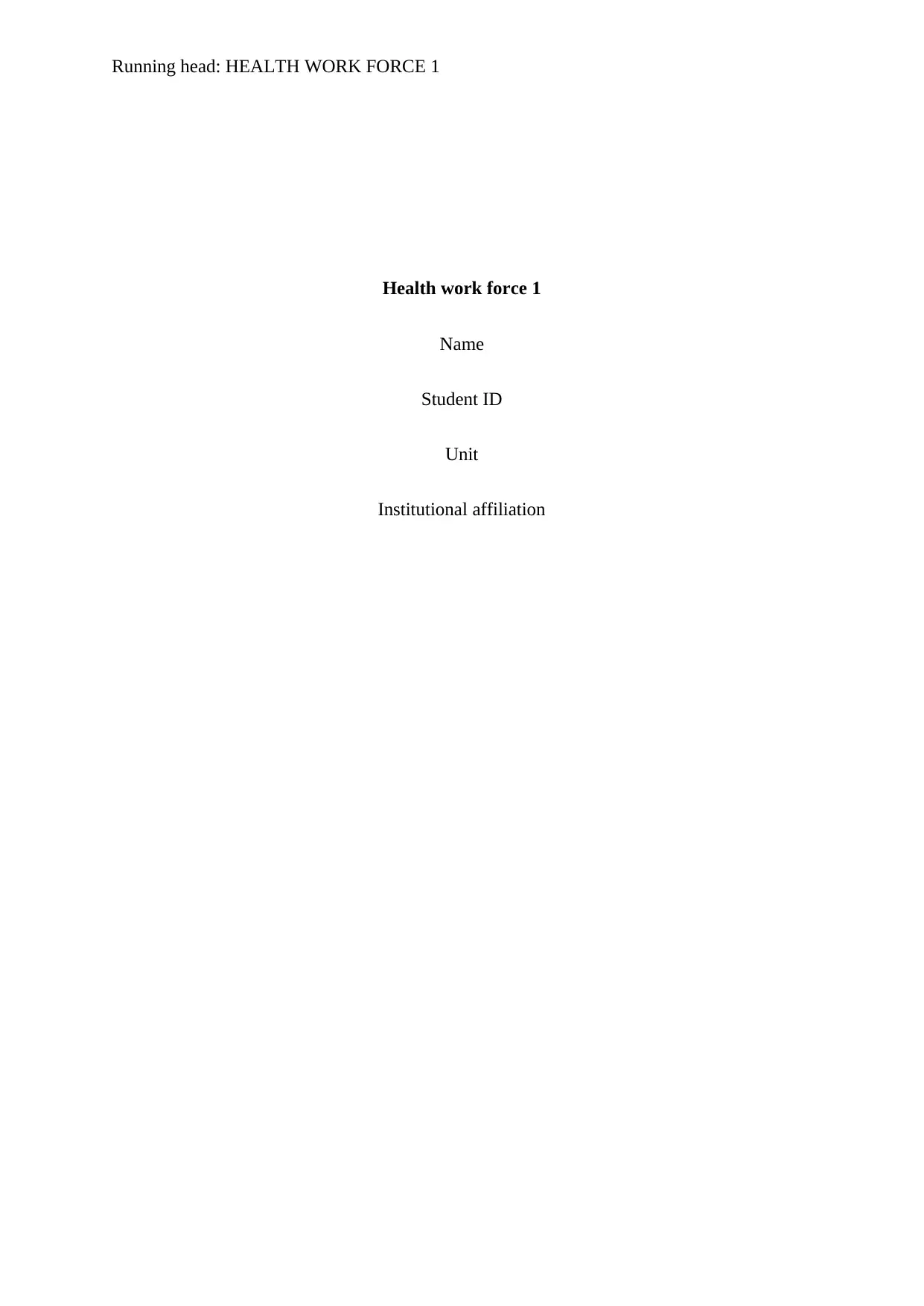
Running head: HEALTH WORK FORCE 1
Health work force 1
Name
Student ID
Unit
Institutional affiliation
Health work force 1
Name
Student ID
Unit
Institutional affiliation
Paraphrase This Document
Need a fresh take? Get an instant paraphrase of this document with our AI Paraphraser
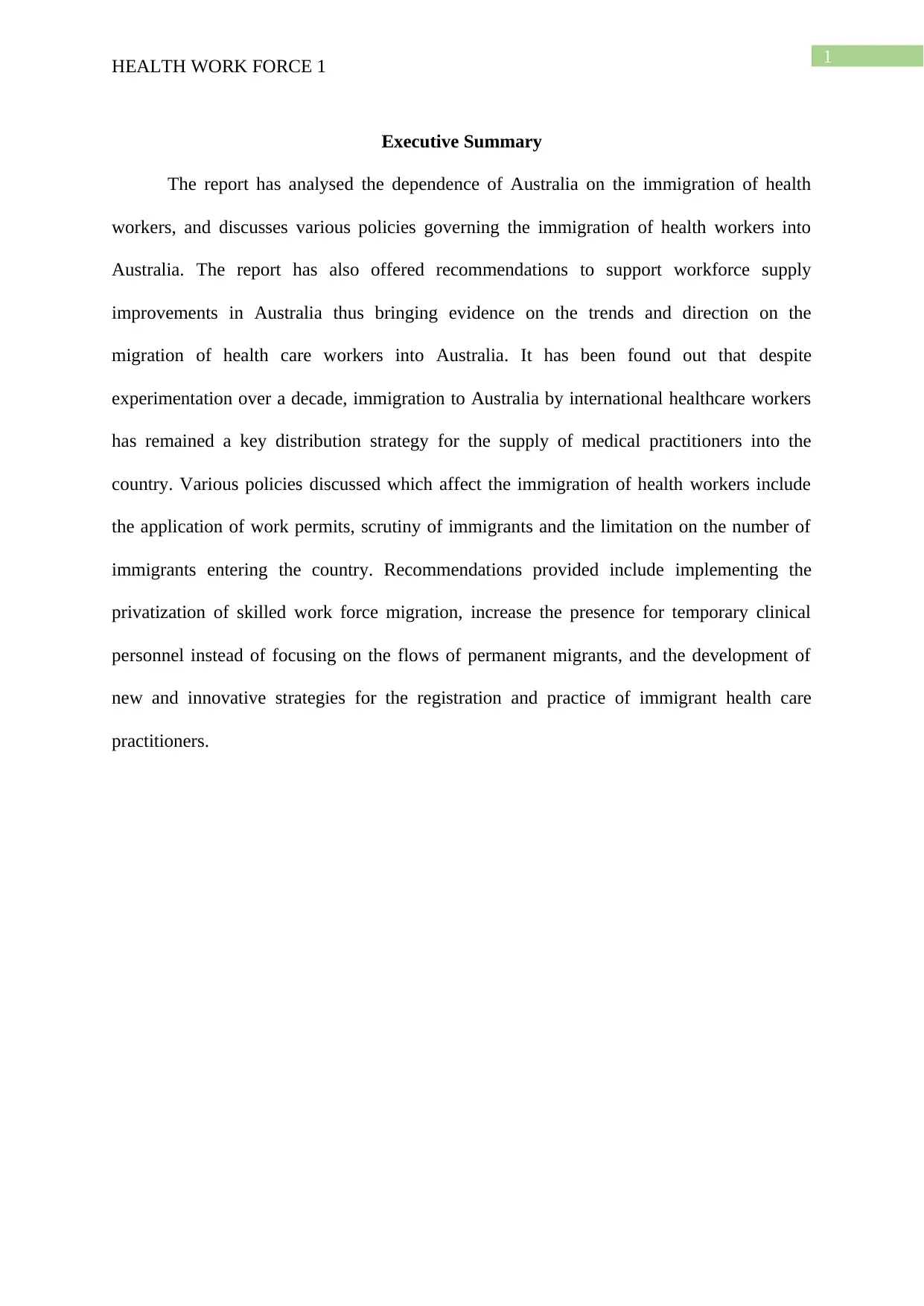
1
HEALTH WORK FORCE 1
Executive Summary
The report has analysed the dependence of Australia on the immigration of health
workers, and discusses various policies governing the immigration of health workers into
Australia. The report has also offered recommendations to support workforce supply
improvements in Australia thus bringing evidence on the trends and direction on the
migration of health care workers into Australia. It has been found out that despite
experimentation over a decade, immigration to Australia by international healthcare workers
has remained a key distribution strategy for the supply of medical practitioners into the
country. Various policies discussed which affect the immigration of health workers include
the application of work permits, scrutiny of immigrants and the limitation on the number of
immigrants entering the country. Recommendations provided include implementing the
privatization of skilled work force migration, increase the presence for temporary clinical
personnel instead of focusing on the flows of permanent migrants, and the development of
new and innovative strategies for the registration and practice of immigrant health care
practitioners.
HEALTH WORK FORCE 1
Executive Summary
The report has analysed the dependence of Australia on the immigration of health
workers, and discusses various policies governing the immigration of health workers into
Australia. The report has also offered recommendations to support workforce supply
improvements in Australia thus bringing evidence on the trends and direction on the
migration of health care workers into Australia. It has been found out that despite
experimentation over a decade, immigration to Australia by international healthcare workers
has remained a key distribution strategy for the supply of medical practitioners into the
country. Various policies discussed which affect the immigration of health workers include
the application of work permits, scrutiny of immigrants and the limitation on the number of
immigrants entering the country. Recommendations provided include implementing the
privatization of skilled work force migration, increase the presence for temporary clinical
personnel instead of focusing on the flows of permanent migrants, and the development of
new and innovative strategies for the registration and practice of immigrant health care
practitioners.
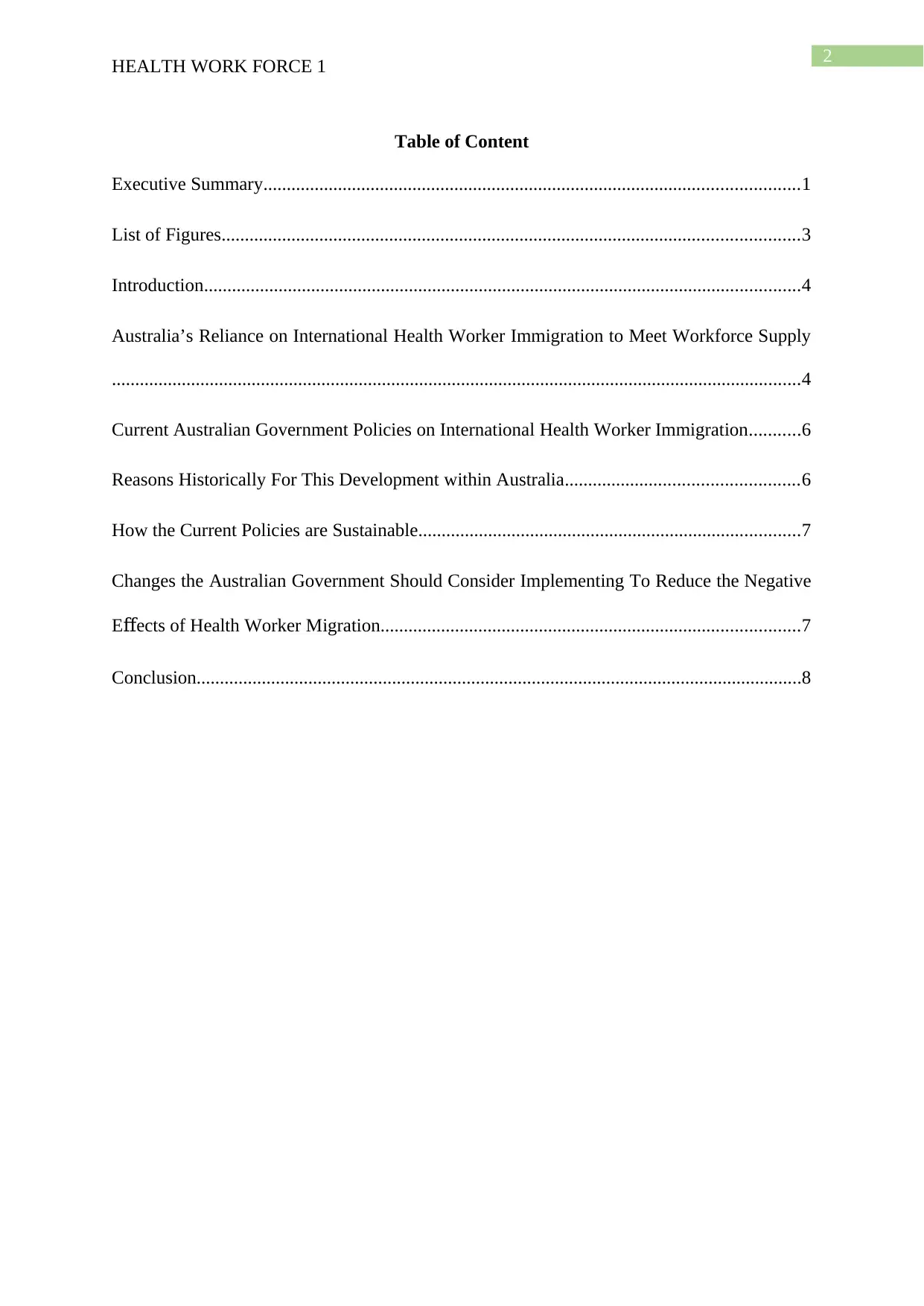
2
HEALTH WORK FORCE 1
Table of Content
Executive Summary...................................................................................................................1
List of Figures............................................................................................................................3
Introduction................................................................................................................................4
Australia’s Reliance on International Health Worker Immigration to Meet Workforce Supply
....................................................................................................................................................4
Current Australian Government Policies on International Health Worker Immigration...........6
Reasons Historically For This Development within Australia..................................................6
How the Current Policies are Sustainable..................................................................................7
Changes the Australian Government Should Consider Implementing To Reduce the Negative
Effects of Health Worker Migration..........................................................................................7
Conclusion..................................................................................................................................8
HEALTH WORK FORCE 1
Table of Content
Executive Summary...................................................................................................................1
List of Figures............................................................................................................................3
Introduction................................................................................................................................4
Australia’s Reliance on International Health Worker Immigration to Meet Workforce Supply
....................................................................................................................................................4
Current Australian Government Policies on International Health Worker Immigration...........6
Reasons Historically For This Development within Australia..................................................6
How the Current Policies are Sustainable..................................................................................7
Changes the Australian Government Should Consider Implementing To Reduce the Negative
Effects of Health Worker Migration..........................................................................................7
Conclusion..................................................................................................................................8
⊘ This is a preview!⊘
Do you want full access?
Subscribe today to unlock all pages.

Trusted by 1+ million students worldwide
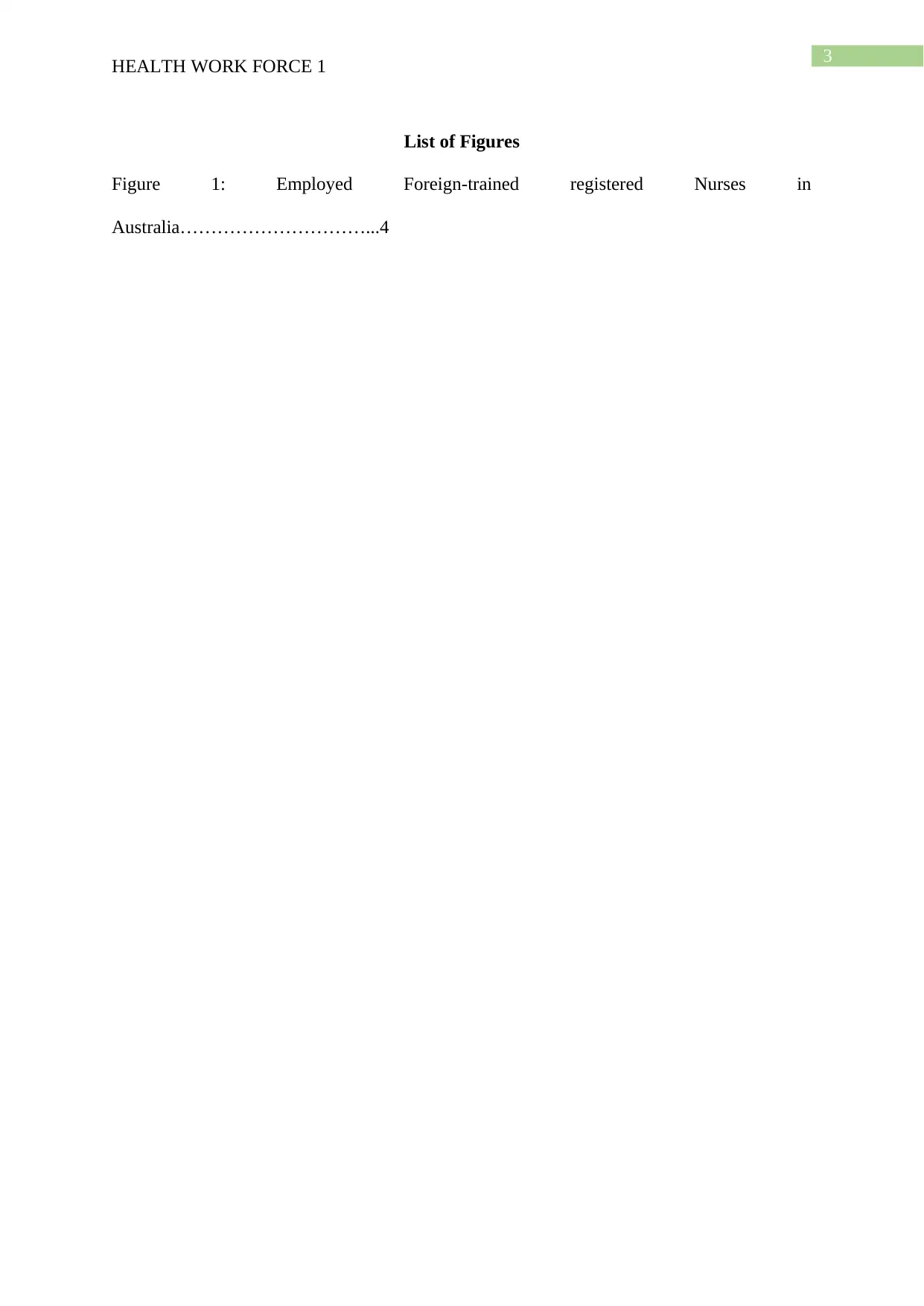
3
HEALTH WORK FORCE 1
List of Figures
Figure 1: Employed Foreign-trained registered Nurses in
Australia…………………………...4
HEALTH WORK FORCE 1
List of Figures
Figure 1: Employed Foreign-trained registered Nurses in
Australia…………………………...4
Paraphrase This Document
Need a fresh take? Get an instant paraphrase of this document with our AI Paraphraser
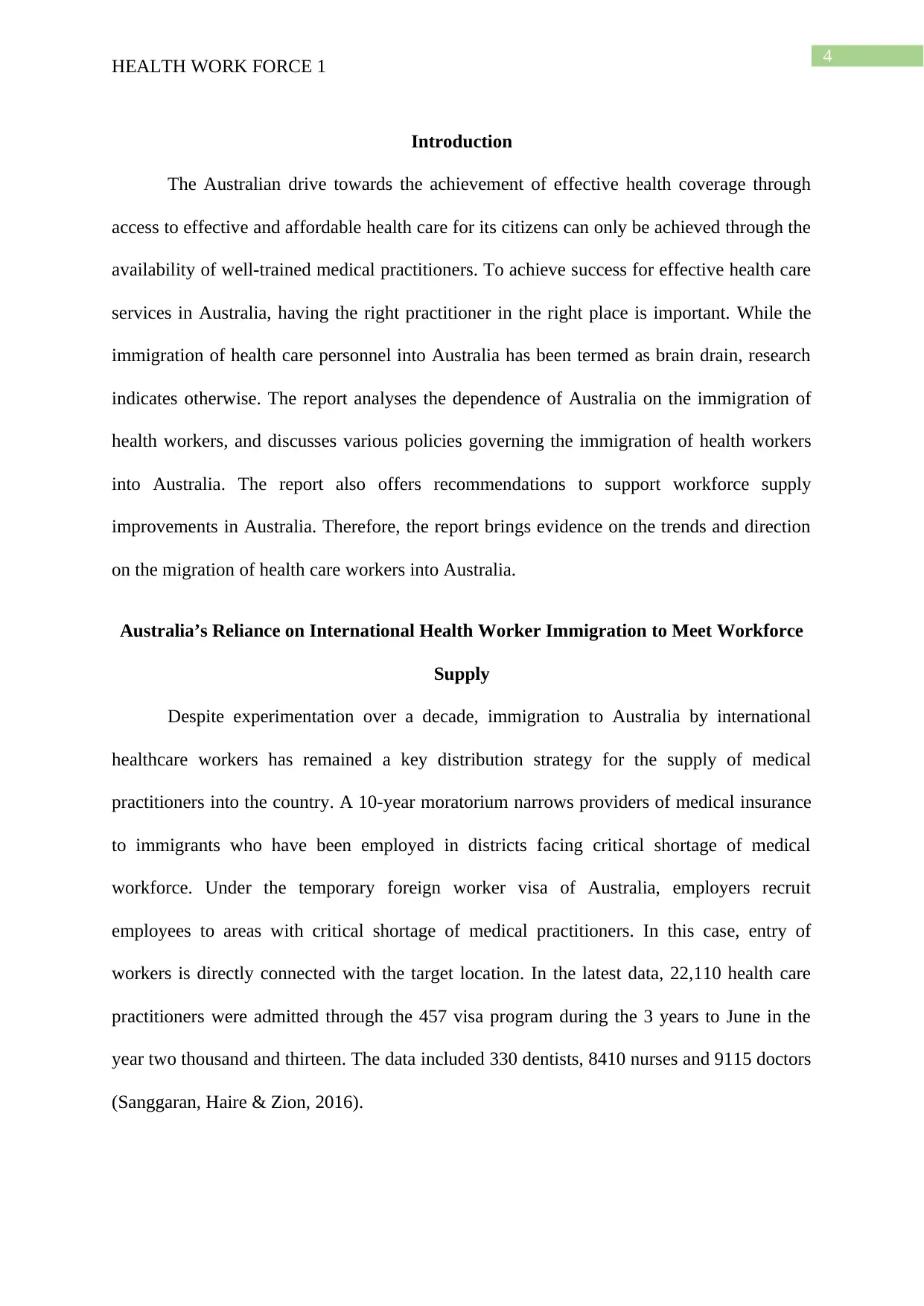
4
HEALTH WORK FORCE 1
Introduction
The Australian drive towards the achievement of effective health coverage through
access to effective and affordable health care for its citizens can only be achieved through the
availability of well-trained medical practitioners. To achieve success for effective health care
services in Australia, having the right practitioner in the right place is important. While the
immigration of health care personnel into Australia has been termed as brain drain, research
indicates otherwise. The report analyses the dependence of Australia on the immigration of
health workers, and discusses various policies governing the immigration of health workers
into Australia. The report also offers recommendations to support workforce supply
improvements in Australia. Therefore, the report brings evidence on the trends and direction
on the migration of health care workers into Australia.
Australia’s Reliance on International Health Worker Immigration to Meet Workforce
Supply
Despite experimentation over a decade, immigration to Australia by international
healthcare workers has remained a key distribution strategy for the supply of medical
practitioners into the country. A 10-year moratorium narrows providers of medical insurance
to immigrants who have been employed in districts facing critical shortage of medical
workforce. Under the temporary foreign worker visa of Australia, employers recruit
employees to areas with critical shortage of medical practitioners. In this case, entry of
workers is directly connected with the target location. In the latest data, 22,110 health care
practitioners were admitted through the 457 visa program during the 3 years to June in the
year two thousand and thirteen. The data included 330 dentists, 8410 nurses and 9115 doctors
(Sanggaran, Haire & Zion, 2016).
HEALTH WORK FORCE 1
Introduction
The Australian drive towards the achievement of effective health coverage through
access to effective and affordable health care for its citizens can only be achieved through the
availability of well-trained medical practitioners. To achieve success for effective health care
services in Australia, having the right practitioner in the right place is important. While the
immigration of health care personnel into Australia has been termed as brain drain, research
indicates otherwise. The report analyses the dependence of Australia on the immigration of
health workers, and discusses various policies governing the immigration of health workers
into Australia. The report also offers recommendations to support workforce supply
improvements in Australia. Therefore, the report brings evidence on the trends and direction
on the migration of health care workers into Australia.
Australia’s Reliance on International Health Worker Immigration to Meet Workforce
Supply
Despite experimentation over a decade, immigration to Australia by international
healthcare workers has remained a key distribution strategy for the supply of medical
practitioners into the country. A 10-year moratorium narrows providers of medical insurance
to immigrants who have been employed in districts facing critical shortage of medical
workforce. Under the temporary foreign worker visa of Australia, employers recruit
employees to areas with critical shortage of medical practitioners. In this case, entry of
workers is directly connected with the target location. In the latest data, 22,110 health care
practitioners were admitted through the 457 visa program during the 3 years to June in the
year two thousand and thirteen. The data included 330 dentists, 8410 nurses and 9115 doctors
(Sanggaran, Haire & Zion, 2016).
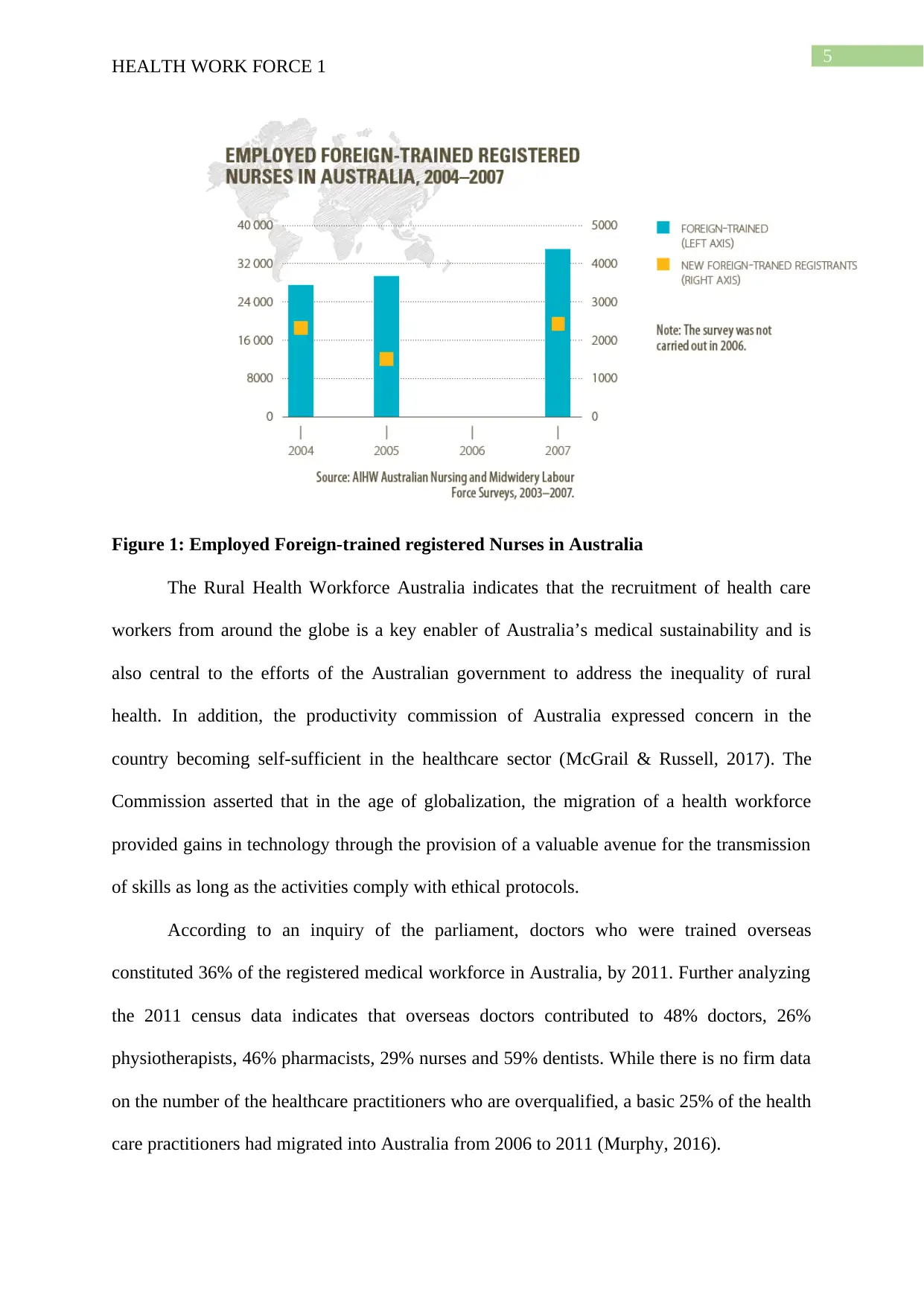
5
HEALTH WORK FORCE 1
Figure 1: Employed Foreign-trained registered Nurses in Australia
The Rural Health Workforce Australia indicates that the recruitment of health care
workers from around the globe is a key enabler of Australia’s medical sustainability and is
also central to the efforts of the Australian government to address the inequality of rural
health. In addition, the productivity commission of Australia expressed concern in the
country becoming self-sufficient in the healthcare sector (McGrail & Russell, 2017). The
Commission asserted that in the age of globalization, the migration of a health workforce
provided gains in technology through the provision of a valuable avenue for the transmission
of skills as long as the activities comply with ethical protocols.
According to an inquiry of the parliament, doctors who were trained overseas
constituted 36% of the registered medical workforce in Australia, by 2011. Further analyzing
the 2011 census data indicates that overseas doctors contributed to 48% doctors, 26%
physiotherapists, 46% pharmacists, 29% nurses and 59% dentists. While there is no firm data
on the number of the healthcare practitioners who are overqualified, a basic 25% of the health
care practitioners had migrated into Australia from 2006 to 2011 (Murphy, 2016).
HEALTH WORK FORCE 1
Figure 1: Employed Foreign-trained registered Nurses in Australia
The Rural Health Workforce Australia indicates that the recruitment of health care
workers from around the globe is a key enabler of Australia’s medical sustainability and is
also central to the efforts of the Australian government to address the inequality of rural
health. In addition, the productivity commission of Australia expressed concern in the
country becoming self-sufficient in the healthcare sector (McGrail & Russell, 2017). The
Commission asserted that in the age of globalization, the migration of a health workforce
provided gains in technology through the provision of a valuable avenue for the transmission
of skills as long as the activities comply with ethical protocols.
According to an inquiry of the parliament, doctors who were trained overseas
constituted 36% of the registered medical workforce in Australia, by 2011. Further analyzing
the 2011 census data indicates that overseas doctors contributed to 48% doctors, 26%
physiotherapists, 46% pharmacists, 29% nurses and 59% dentists. While there is no firm data
on the number of the healthcare practitioners who are overqualified, a basic 25% of the health
care practitioners had migrated into Australia from 2006 to 2011 (Murphy, 2016).
⊘ This is a preview!⊘
Do you want full access?
Subscribe today to unlock all pages.

Trusted by 1+ million students worldwide
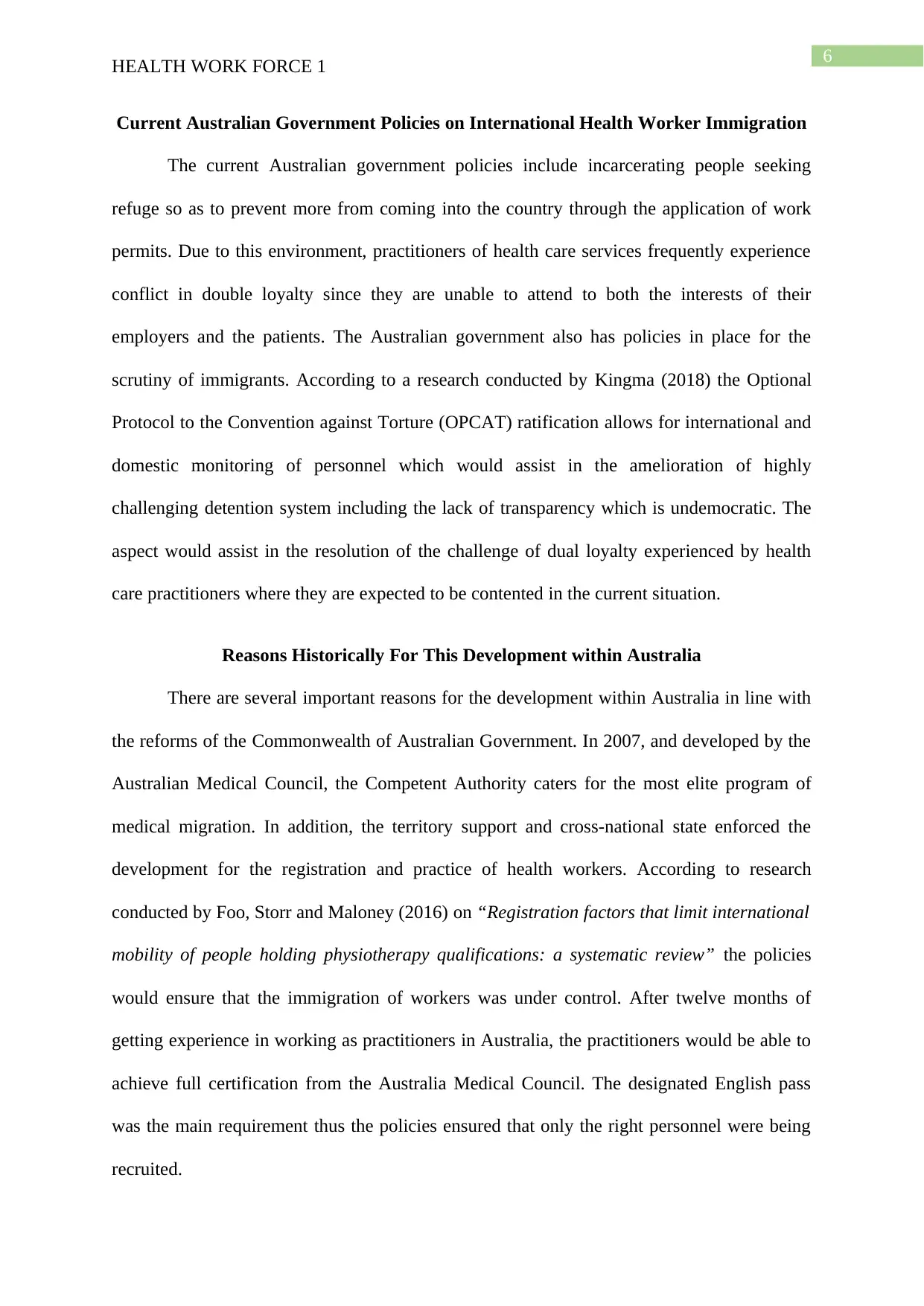
6
HEALTH WORK FORCE 1
Current Australian Government Policies on International Health Worker Immigration
The current Australian government policies include incarcerating people seeking
refuge so as to prevent more from coming into the country through the application of work
permits. Due to this environment, practitioners of health care services frequently experience
conflict in double loyalty since they are unable to attend to both the interests of their
employers and the patients. The Australian government also has policies in place for the
scrutiny of immigrants. According to a research conducted by Kingma (2018) the Optional
Protocol to the Convention against Torture (OPCAT) ratification allows for international and
domestic monitoring of personnel which would assist in the amelioration of highly
challenging detention system including the lack of transparency which is undemocratic. The
aspect would assist in the resolution of the challenge of dual loyalty experienced by health
care practitioners where they are expected to be contented in the current situation.
Reasons Historically For This Development within Australia
There are several important reasons for the development within Australia in line with
the reforms of the Commonwealth of Australian Government. In 2007, and developed by the
Australian Medical Council, the Competent Authority caters for the most elite program of
medical migration. In addition, the territory support and cross-national state enforced the
development for the registration and practice of health workers. According to research
conducted by Foo, Storr and Maloney (2016) on “Registration factors that limit international
mobility of people holding physiotherapy qualifications: a systematic review” the policies
would ensure that the immigration of workers was under control. After twelve months of
getting experience in working as practitioners in Australia, the practitioners would be able to
achieve full certification from the Australia Medical Council. The designated English pass
was the main requirement thus the policies ensured that only the right personnel were being
recruited.
HEALTH WORK FORCE 1
Current Australian Government Policies on International Health Worker Immigration
The current Australian government policies include incarcerating people seeking
refuge so as to prevent more from coming into the country through the application of work
permits. Due to this environment, practitioners of health care services frequently experience
conflict in double loyalty since they are unable to attend to both the interests of their
employers and the patients. The Australian government also has policies in place for the
scrutiny of immigrants. According to a research conducted by Kingma (2018) the Optional
Protocol to the Convention against Torture (OPCAT) ratification allows for international and
domestic monitoring of personnel which would assist in the amelioration of highly
challenging detention system including the lack of transparency which is undemocratic. The
aspect would assist in the resolution of the challenge of dual loyalty experienced by health
care practitioners where they are expected to be contented in the current situation.
Reasons Historically For This Development within Australia
There are several important reasons for the development within Australia in line with
the reforms of the Commonwealth of Australian Government. In 2007, and developed by the
Australian Medical Council, the Competent Authority caters for the most elite program of
medical migration. In addition, the territory support and cross-national state enforced the
development for the registration and practice of health workers. According to research
conducted by Foo, Storr and Maloney (2016) on “Registration factors that limit international
mobility of people holding physiotherapy qualifications: a systematic review” the policies
would ensure that the immigration of workers was under control. After twelve months of
getting experience in working as practitioners in Australia, the practitioners would be able to
achieve full certification from the Australia Medical Council. The designated English pass
was the main requirement thus the policies ensured that only the right personnel were being
recruited.
Paraphrase This Document
Need a fresh take? Get an instant paraphrase of this document with our AI Paraphraser
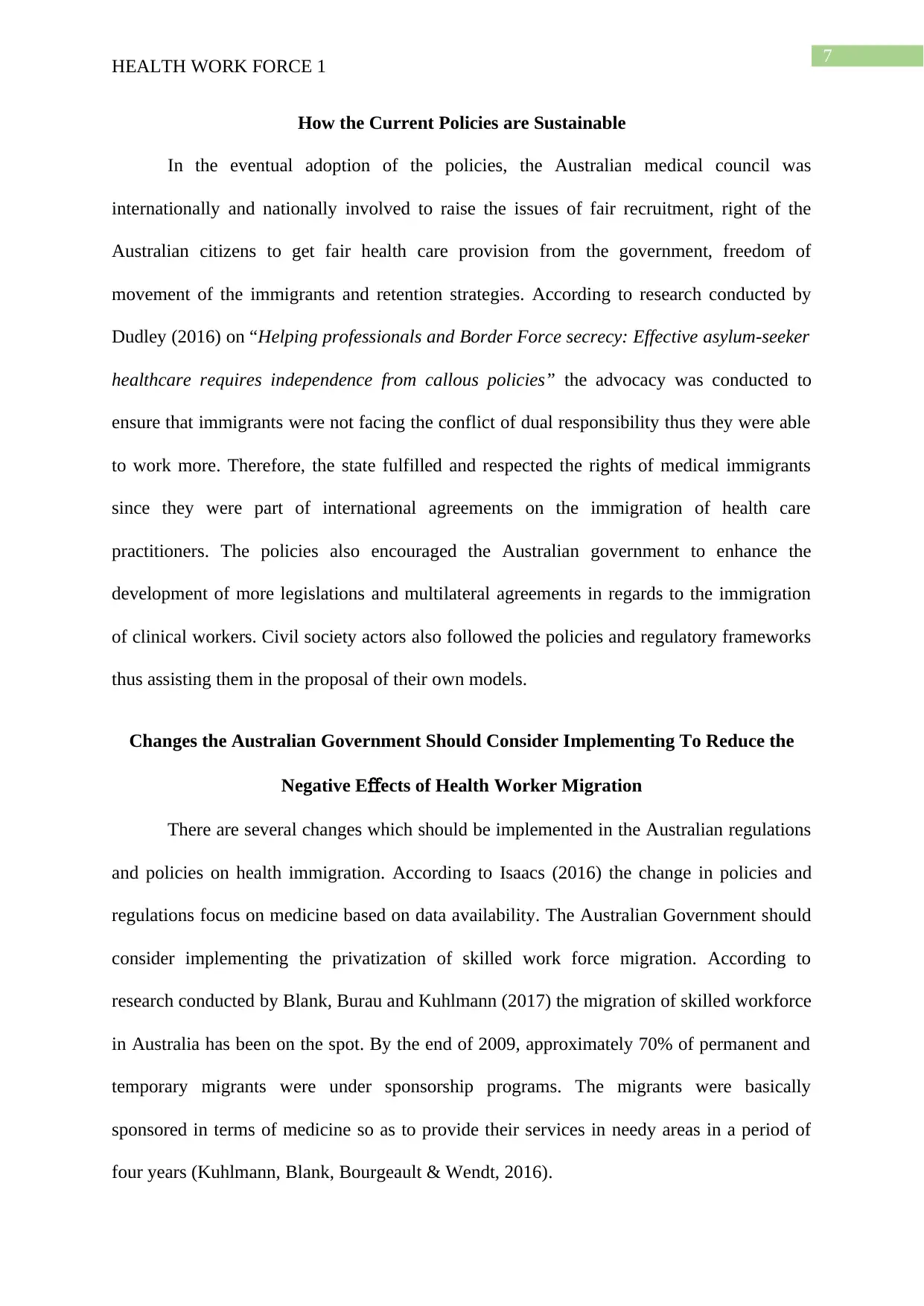
7
HEALTH WORK FORCE 1
How the Current Policies are Sustainable
In the eventual adoption of the policies, the Australian medical council was
internationally and nationally involved to raise the issues of fair recruitment, right of the
Australian citizens to get fair health care provision from the government, freedom of
movement of the immigrants and retention strategies. According to research conducted by
Dudley (2016) on “Helping professionals and Border Force secrecy: Effective asylum-seeker
healthcare requires independence from callous policies” the advocacy was conducted to
ensure that immigrants were not facing the conflict of dual responsibility thus they were able
to work more. Therefore, the state fulfilled and respected the rights of medical immigrants
since they were part of international agreements on the immigration of health care
practitioners. The policies also encouraged the Australian government to enhance the
development of more legislations and multilateral agreements in regards to the immigration
of clinical workers. Civil society actors also followed the policies and regulatory frameworks
thus assisting them in the proposal of their own models.
Changes the Australian Government Should Consider Implementing To Reduce the
Negative Effects of Health Worker Migration
There are several changes which should be implemented in the Australian regulations
and policies on health immigration. According to Isaacs (2016) the change in policies and
regulations focus on medicine based on data availability. The Australian Government should
consider implementing the privatization of skilled work force migration. According to
research conducted by Blank, Burau and Kuhlmann (2017) the migration of skilled workforce
in Australia has been on the spot. By the end of 2009, approximately 70% of permanent and
temporary migrants were under sponsorship programs. The migrants were basically
sponsored in terms of medicine so as to provide their services in needy areas in a period of
four years (Kuhlmann, Blank, Bourgeault & Wendt, 2016).
HEALTH WORK FORCE 1
How the Current Policies are Sustainable
In the eventual adoption of the policies, the Australian medical council was
internationally and nationally involved to raise the issues of fair recruitment, right of the
Australian citizens to get fair health care provision from the government, freedom of
movement of the immigrants and retention strategies. According to research conducted by
Dudley (2016) on “Helping professionals and Border Force secrecy: Effective asylum-seeker
healthcare requires independence from callous policies” the advocacy was conducted to
ensure that immigrants were not facing the conflict of dual responsibility thus they were able
to work more. Therefore, the state fulfilled and respected the rights of medical immigrants
since they were part of international agreements on the immigration of health care
practitioners. The policies also encouraged the Australian government to enhance the
development of more legislations and multilateral agreements in regards to the immigration
of clinical workers. Civil society actors also followed the policies and regulatory frameworks
thus assisting them in the proposal of their own models.
Changes the Australian Government Should Consider Implementing To Reduce the
Negative Effects of Health Worker Migration
There are several changes which should be implemented in the Australian regulations
and policies on health immigration. According to Isaacs (2016) the change in policies and
regulations focus on medicine based on data availability. The Australian Government should
consider implementing the privatization of skilled work force migration. According to
research conducted by Blank, Burau and Kuhlmann (2017) the migration of skilled workforce
in Australia has been on the spot. By the end of 2009, approximately 70% of permanent and
temporary migrants were under sponsorship programs. The migrants were basically
sponsored in terms of medicine so as to provide their services in needy areas in a period of
four years (Kuhlmann, Blank, Bourgeault & Wendt, 2016).
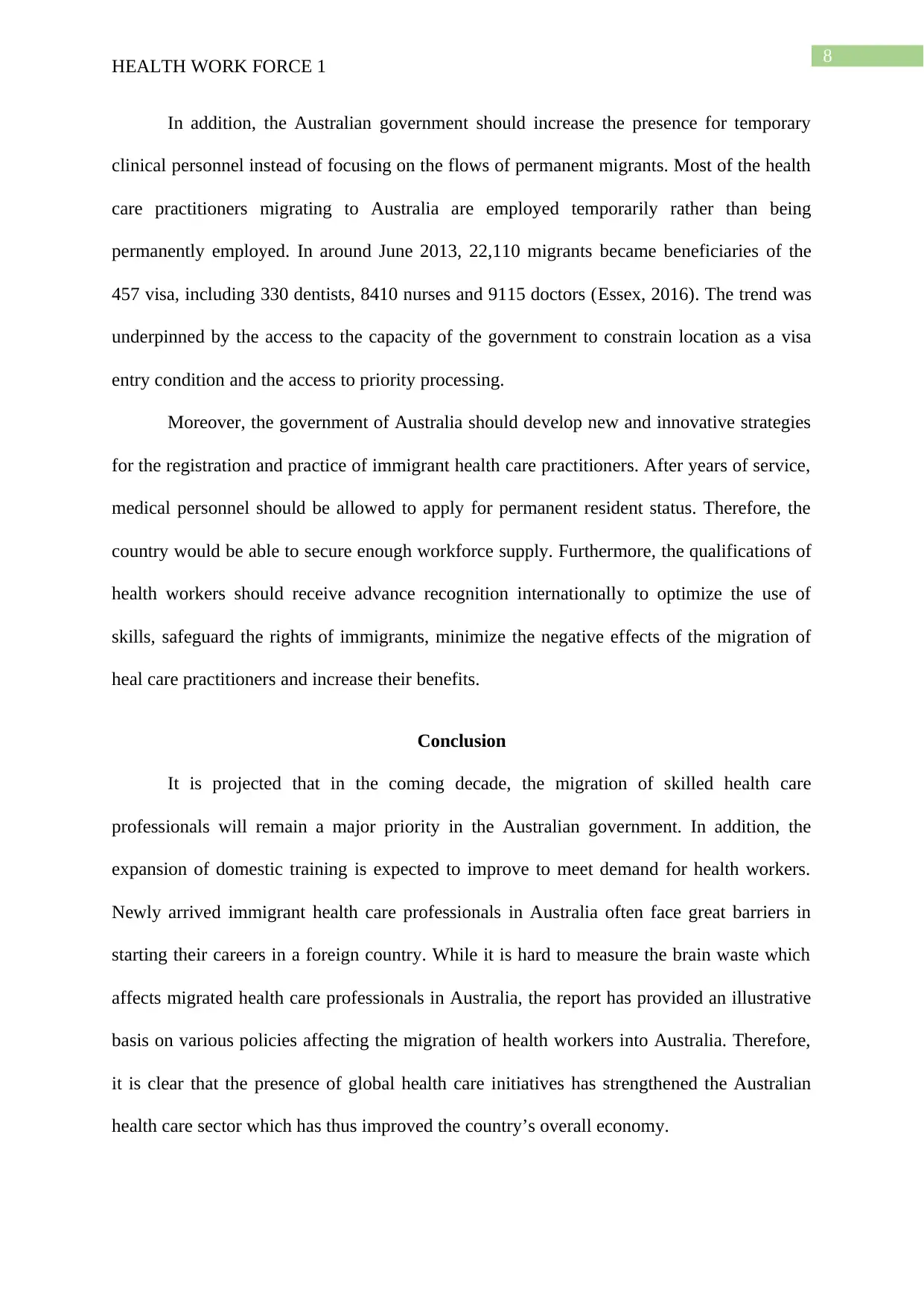
8
HEALTH WORK FORCE 1
In addition, the Australian government should increase the presence for temporary
clinical personnel instead of focusing on the flows of permanent migrants. Most of the health
care practitioners migrating to Australia are employed temporarily rather than being
permanently employed. In around June 2013, 22,110 migrants became beneficiaries of the
457 visa, including 330 dentists, 8410 nurses and 9115 doctors (Essex, 2016). The trend was
underpinned by the access to the capacity of the government to constrain location as a visa
entry condition and the access to priority processing.
Moreover, the government of Australia should develop new and innovative strategies
for the registration and practice of immigrant health care practitioners. After years of service,
medical personnel should be allowed to apply for permanent resident status. Therefore, the
country would be able to secure enough workforce supply. Furthermore, the qualifications of
health workers should receive advance recognition internationally to optimize the use of
skills, safeguard the rights of immigrants, minimize the negative effects of the migration of
heal care practitioners and increase their benefits.
Conclusion
It is projected that in the coming decade, the migration of skilled health care
professionals will remain a major priority in the Australian government. In addition, the
expansion of domestic training is expected to improve to meet demand for health workers.
Newly arrived immigrant health care professionals in Australia often face great barriers in
starting their careers in a foreign country. While it is hard to measure the brain waste which
affects migrated health care professionals in Australia, the report has provided an illustrative
basis on various policies affecting the migration of health workers into Australia. Therefore,
it is clear that the presence of global health care initiatives has strengthened the Australian
health care sector which has thus improved the country’s overall economy.
HEALTH WORK FORCE 1
In addition, the Australian government should increase the presence for temporary
clinical personnel instead of focusing on the flows of permanent migrants. Most of the health
care practitioners migrating to Australia are employed temporarily rather than being
permanently employed. In around June 2013, 22,110 migrants became beneficiaries of the
457 visa, including 330 dentists, 8410 nurses and 9115 doctors (Essex, 2016). The trend was
underpinned by the access to the capacity of the government to constrain location as a visa
entry condition and the access to priority processing.
Moreover, the government of Australia should develop new and innovative strategies
for the registration and practice of immigrant health care practitioners. After years of service,
medical personnel should be allowed to apply for permanent resident status. Therefore, the
country would be able to secure enough workforce supply. Furthermore, the qualifications of
health workers should receive advance recognition internationally to optimize the use of
skills, safeguard the rights of immigrants, minimize the negative effects of the migration of
heal care practitioners and increase their benefits.
Conclusion
It is projected that in the coming decade, the migration of skilled health care
professionals will remain a major priority in the Australian government. In addition, the
expansion of domestic training is expected to improve to meet demand for health workers.
Newly arrived immigrant health care professionals in Australia often face great barriers in
starting their careers in a foreign country. While it is hard to measure the brain waste which
affects migrated health care professionals in Australia, the report has provided an illustrative
basis on various policies affecting the migration of health workers into Australia. Therefore,
it is clear that the presence of global health care initiatives has strengthened the Australian
health care sector which has thus improved the country’s overall economy.
⊘ This is a preview!⊘
Do you want full access?
Subscribe today to unlock all pages.

Trusted by 1+ million students worldwide
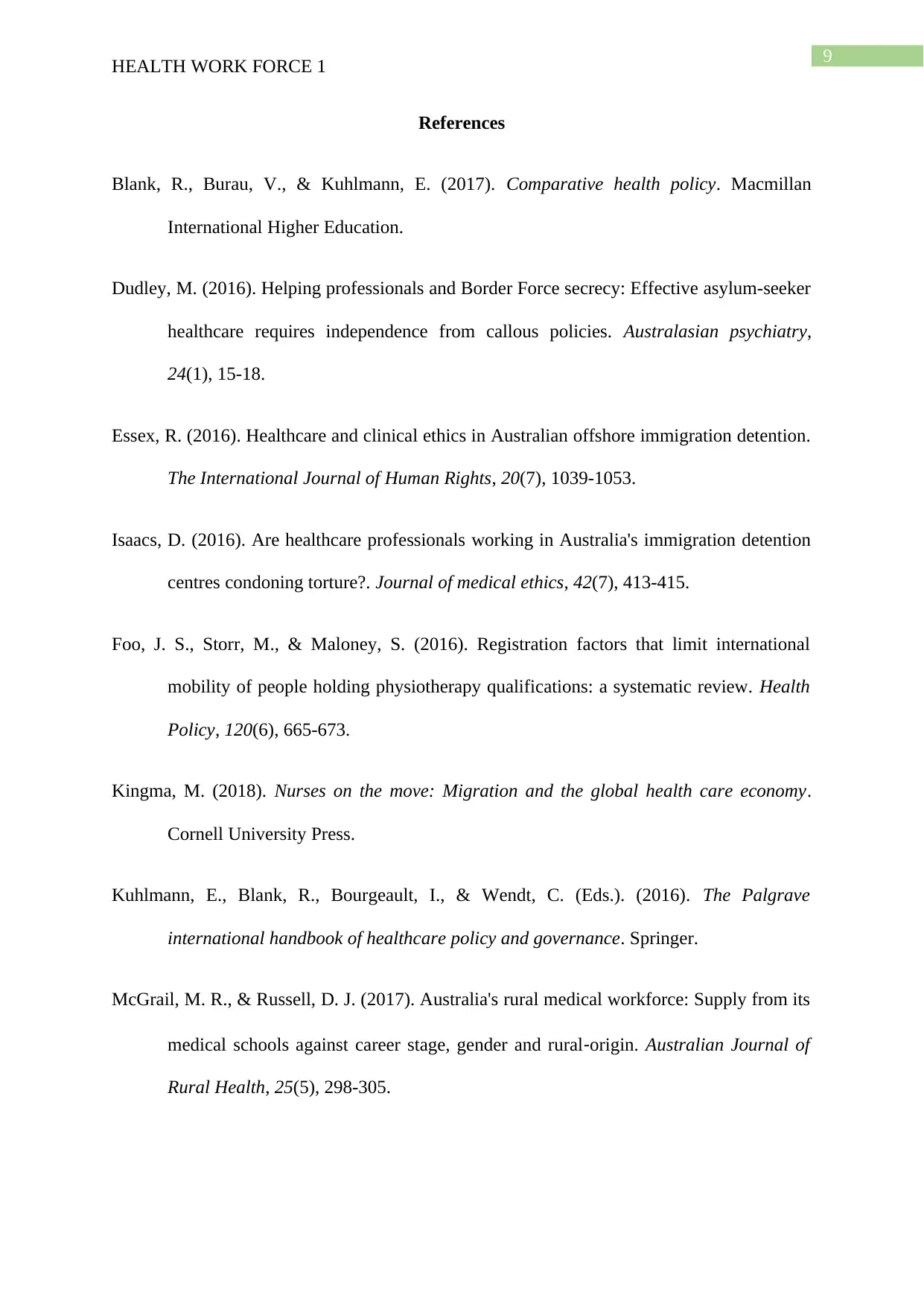
9
HEALTH WORK FORCE 1
References
Blank, R., Burau, V., & Kuhlmann, E. (2017). Comparative health policy. Macmillan
International Higher Education.
Dudley, M. (2016). Helping professionals and Border Force secrecy: Effective asylum-seeker
healthcare requires independence from callous policies. Australasian psychiatry,
24(1), 15-18.
Essex, R. (2016). Healthcare and clinical ethics in Australian offshore immigration detention.
The International Journal of Human Rights, 20(7), 1039-1053.
Isaacs, D. (2016). Are healthcare professionals working in Australia's immigration detention
centres condoning torture?. Journal of medical ethics, 42(7), 413-415.
Foo, J. S., Storr, M., & Maloney, S. (2016). Registration factors that limit international
mobility of people holding physiotherapy qualifications: a systematic review. Health
Policy, 120(6), 665-673.
Kingma, M. (2018). Nurses on the move: Migration and the global health care economy.
Cornell University Press.
Kuhlmann, E., Blank, R., Bourgeault, I., & Wendt, C. (Eds.). (2016). The Palgrave
international handbook of healthcare policy and governance. Springer.
McGrail, M. R., & Russell, D. J. (2017). Australia's rural medical workforce: Supply from its
medical schools against career stage, gender and rural‐origin. Australian Journal of
Rural Health, 25(5), 298-305.
HEALTH WORK FORCE 1
References
Blank, R., Burau, V., & Kuhlmann, E. (2017). Comparative health policy. Macmillan
International Higher Education.
Dudley, M. (2016). Helping professionals and Border Force secrecy: Effective asylum-seeker
healthcare requires independence from callous policies. Australasian psychiatry,
24(1), 15-18.
Essex, R. (2016). Healthcare and clinical ethics in Australian offshore immigration detention.
The International Journal of Human Rights, 20(7), 1039-1053.
Isaacs, D. (2016). Are healthcare professionals working in Australia's immigration detention
centres condoning torture?. Journal of medical ethics, 42(7), 413-415.
Foo, J. S., Storr, M., & Maloney, S. (2016). Registration factors that limit international
mobility of people holding physiotherapy qualifications: a systematic review. Health
Policy, 120(6), 665-673.
Kingma, M. (2018). Nurses on the move: Migration and the global health care economy.
Cornell University Press.
Kuhlmann, E., Blank, R., Bourgeault, I., & Wendt, C. (Eds.). (2016). The Palgrave
international handbook of healthcare policy and governance. Springer.
McGrail, M. R., & Russell, D. J. (2017). Australia's rural medical workforce: Supply from its
medical schools against career stage, gender and rural‐origin. Australian Journal of
Rural Health, 25(5), 298-305.
Paraphrase This Document
Need a fresh take? Get an instant paraphrase of this document with our AI Paraphraser
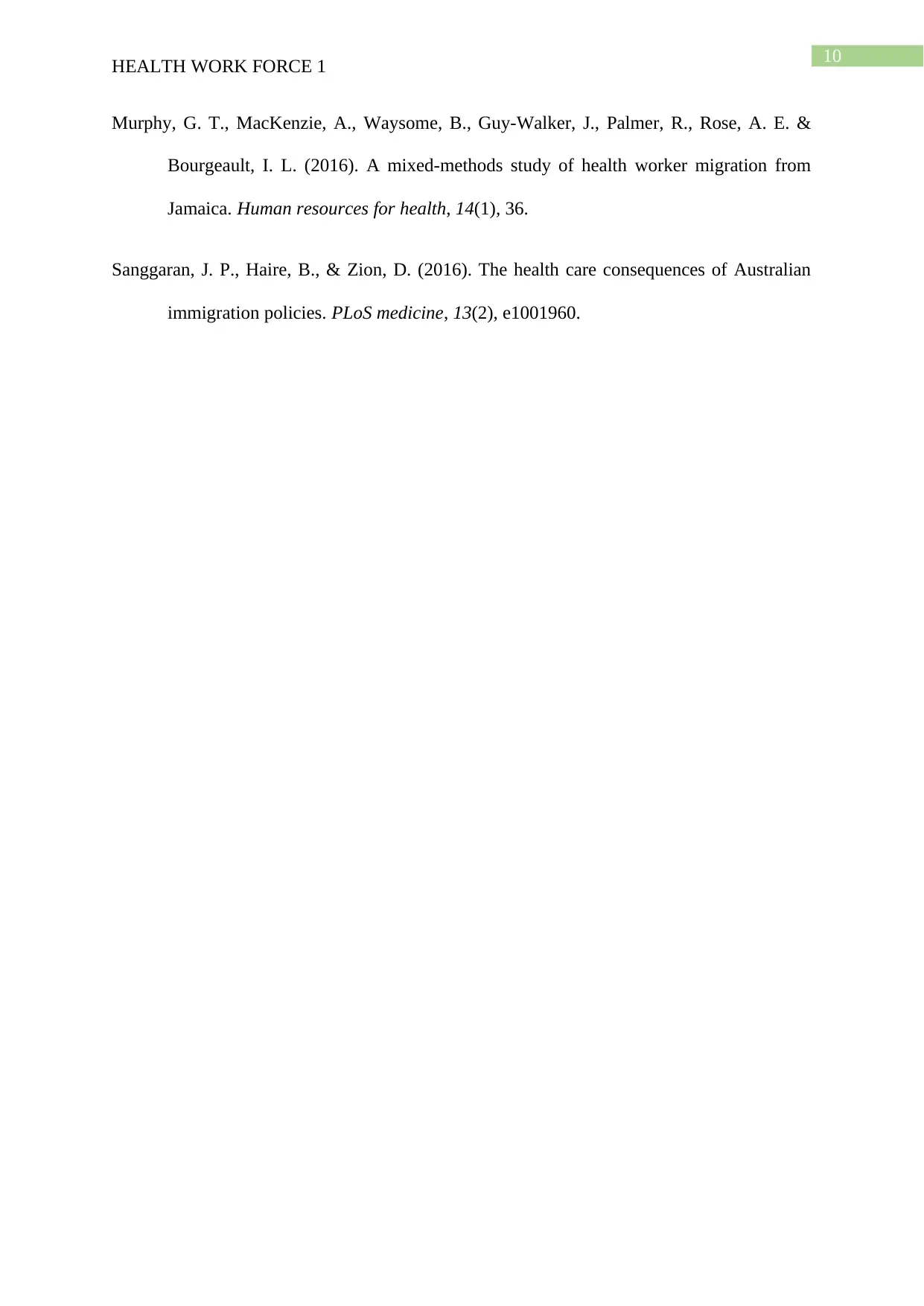
10
HEALTH WORK FORCE 1
Murphy, G. T., MacKenzie, A., Waysome, B., Guy-Walker, J., Palmer, R., Rose, A. E. &
Bourgeault, I. L. (2016). A mixed-methods study of health worker migration from
Jamaica. Human resources for health, 14(1), 36.
Sanggaran, J. P., Haire, B., & Zion, D. (2016). The health care consequences of Australian
immigration policies. PLoS medicine, 13(2), e1001960.
HEALTH WORK FORCE 1
Murphy, G. T., MacKenzie, A., Waysome, B., Guy-Walker, J., Palmer, R., Rose, A. E. &
Bourgeault, I. L. (2016). A mixed-methods study of health worker migration from
Jamaica. Human resources for health, 14(1), 36.
Sanggaran, J. P., Haire, B., & Zion, D. (2016). The health care consequences of Australian
immigration policies. PLoS medicine, 13(2), e1001960.
1 out of 11
Related Documents
Your All-in-One AI-Powered Toolkit for Academic Success.
+13062052269
info@desklib.com
Available 24*7 on WhatsApp / Email
![[object Object]](/_next/static/media/star-bottom.7253800d.svg)
Unlock your academic potential
Copyright © 2020–2025 A2Z Services. All Rights Reserved. Developed and managed by ZUCOL.





